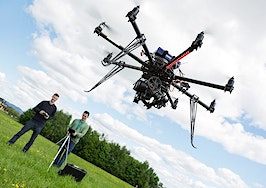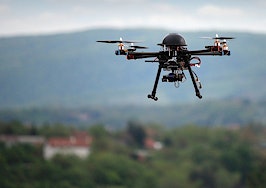Drones have “an incredible array of uses” and are a potential “game changer for the real estate industry,” the National Association of Realtors said this week in a letter to regulators who are drawing up rules that will govern the commercial use of unmanned aerial vehicles (UAVs) — already popular with real estate brokers and agents for marketing property.
Drone imagery is “a creative and dynamic way to present” properties, NAR advised the FAA, giving homebuyers the ability to “evaluate the home’s site and location in the context of the neighborhood and community. Is the neighborhood school walkable, or is that half-mile path listed on a map an unsafe route? Information that could previously only be read or heard about can now be brought to life using images obtained through use of” drones.
For land sales involving properties that may encompass hundreds or thousands of acres, drones let buyers “see the topography, geography, hydrogeology features, as well as examine what plants are growing and what animals live on the property. Spending a few minutes looking at the images collected from an UAV is more efficient and safer than spending hours or days driving around a property or even flying above it in a chartered plane or helicopter.”
Drones may even have environmental benefits, NAR said. A battery-powered drone “emits much less pollution, including CO2, than fueling vehicles, planes or helicopters. Consumers’ ability to view a robust video of a property minimizes the need for them to get into their car and drive to each property to inspect it, thereby further reducing vehicle miles traveled, saving energy, reducing traffic congestion and reducing pollution. “
While NAR said it’s all for rules that protect safety and privacy, it warned that “overly burdensome regulation” would be “detrimental to both the FAA and the development of business use of” drones.
The real estate industry’s use of drones is “simple compared to other applications such as land surveying or law enforcement,” NAR said, alluding to privacy concerns likely to be raised by some who might be observed during such flights.
In real estate, the use of drones “would be limited in scope to the property (being marketed) itself. Properly written regulation would permit the use of (drones) within the real estate industry, while maintaining safety” of the public airspace and privacy of citizens.
Once rules are drafted, NAR pledged to “create materials and resources that will inform Realtors about safe and responsible use of” drones, the trade group said.
NAR also scolded the FAA for using the term “Realtors” in an advisory issued in June that was clearly aimed at all real estate agents and brokers, not just NAR members. The FAA warned that Realtors using drones to market homes can’t claim to be hobbyists, and could be subject to enforcement actions.
NAR President Steve Brown informed FAA Director Michael Huerta that the advisory “made a common mistake and misused NAR’s Realtor trademarks.”
“The Realtor marks are not synonyms for real estate agents, real estate brokers, or other real estate professionals,” NAR informed the FAA. “Instead, the Realtor marks should only be used when identifying someone as a member of NAR. This type of misuse is easily eliminated by replacing the incorrectly used Realtor mark(s) with an appropriate job title, such as ‘real estate agent.’ ”
This week the FAA granted interim approvals to six Hollywood production companies to operate camera-equipped drones over movie and television sets, which is expected to pave the way for other interim drone approvals. Formal regulations are expected to be adopted next year.






